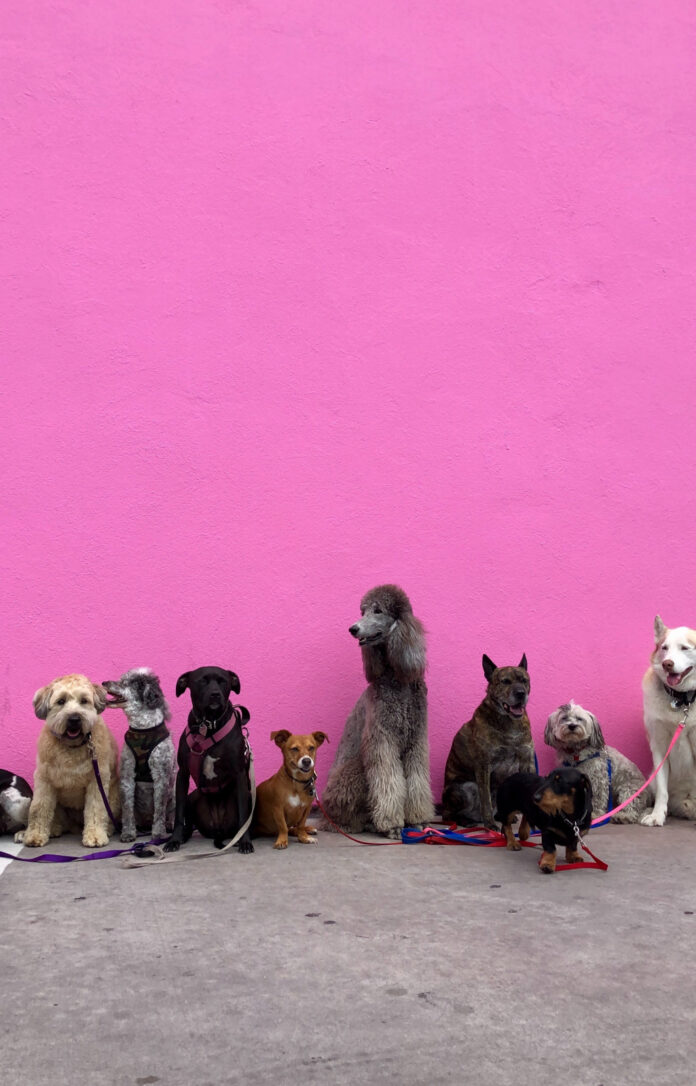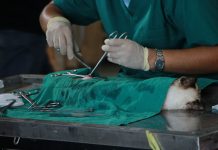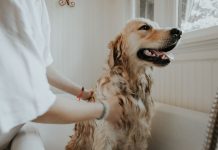Regular grooming is good for every dog – it helps them maintain a clean shiny coat while giving you the chance to check for skin infections and parasite infestations. Plus, grooming improves hygiene and improves the bonding experience for you and your furry friend. Dogs with short coats also need regular bathing, brushing, and trimming of nails. Dogs with a long coat might need hair trimming and clipping. While you may want to hire a professional groomer especially when it comes to trimming your furry friend’s hair, these seven tips will help you establish a grooming routine with your pet at home to make it well-groomed dog. Let’s get started!
Table of Contents
1. Brush your dog’s coat regularly
Your dog will require regular brushing to keep its coat glossy and shiny. The frequency of brushing will depend on the length and texture of your dog’s coat. Breeds with long hair such as collies and golden retrievers will need frequent brushing while shorthaired breeds such as Labradors and greyhounds will need brushing once a week only.
According to the professional writer service, for longhaired breeds, matting can cause severe pain. Dogs usually bite or lick themselves at the source of irritation. And this may lead to skin infections. Foreign bodies can hide inside the coat and even dig deep into the skin thus causing an abscess. Regularly brushing your dog will prevent matting from becoming a major issue.
Short Haired dogs will benefit from brushing immensely. Brushing helps in removing dirt, loose hair, and dander from the coat. And this extends the time between baths.
2. Trim your dog’s hair carefully
Most pet owners prefer taking their furry friends to a professional groomer to have their dog’s hair trimmed. If you do this carefully, you can trim overgrown hair around the paws and eyes in between professional grooming sessions. Trimming the hair around the eyes can prevent overgrown hair from rubbing, blocking, and damaging the eyes.
Always calm your dog before the trimming session. And do this while he is lying down. Move slowly and calmly while exercising caution when the blades are close to the skin. Remember to reward your dog for staying calm with a treat when you’re done.
Trimming hair inside the ears can prevent ear infections and improve air movement. However, this should be done by a professional groomer or at the vet.
Keep in mind that you can cut your pet accidentally with clippers or scissors. Always exercise caution while trimming. If you are nervous, do not trim the dog yourself. Always consult a professional groomer.
3. Check the skin as you groom
Skin diseases are quite common in dogs. And they often scratch, lick or chew their skin. Apart from making your pet feel miserable, external parasites like ticks, fleas, lice, and mites can transfer dangerous diseases. Form the habit of checking your dog’s skin during the grooming process. Start by petting your dog and running your fingers through the coat to feel its skin for unusual bumps or lumps. You can investigate this further by parting the coat to examine the skin closely for rashes, sores, bald spots, and signs of parasitic infections.
4. Don’t bathe your dog too often
As assignment help reports, dogs with healthy skin need to be bathed a few times every couple of months to prevent unpleasant odors and hygiene issues. Bathing your dog too often can lead to the stripping of natural oils thus drying out its skin. If your dog has a bad odor but hasn’t played or rolled in the dirt, then you should visit your vet. It could be a skin infection or a dental disease. Here are a few tips for bathing your dog:
Shampoo
Your vet can provide advice about the best products for your dog. Always go for shampoos that are designed for dogs. Remember, dogs have sensitive skin and their pH is different from that of human skin. Therefore, human shampoo products should never be used on dogs.
For dogs with a healthy coat and skin, go for a gentle and mild hypoallergenic shampoo. For pets with skin conditions, your vet will advise on the type of product or shampoo to use in the management and treatment of skin problems.
You can consider applying a gentle and mild hypoallergenic rinse-out conditioner after cleaning your dog with shampoo to prevent skin dryness. Test patch a few products first to ensure there is no irritation or reaction. If your dog feels irritated, consult your vet and try out other products.
Where to bathe your furry friend
Where you bathe your dog varies depending on your circumstances:
- Outdoors: Some people find it easier to bathe their dogs outside in the backyard. This way, owners avoid lifting particularly large and mid-sized dogs. This is a good option for dogs who always want to jump out of the tub. Some people use a gardening hose and set low pressure. You should always test the temperature of the hose water particularly during the summer as it can be quite hot. If the weather is chilly, you may need to use warm water.
- Bathtub: For some dog owners, a bathtub might be suitable. Observe your pet and note if they seem upset. If you are using a tub, always supervise your dog directly and be present. Let the water run down the drain to avoid filling up the tub. This is important since dogs can easily drown. You can consider using a shower or hose attached to the tub or buckets of water if you don’t have a shower attachment. Test the temperature to ensure that it’s warm and comfortable and your dog is happy. You should also use light water pressure and low flow only.
- Invest in a non-slip mat to the tub of the floor to prevent injuries and slipping. This will help your dog feel comfortable as dogs enjoy being on stable surfaces. You can also place a few mats next to the tub and around the bathroom to prevent slipping.
Drying your dog
While dogs tend to shake off excess water instinctively after getting wet, you will probably need to dry them off with large absorbent towels. After this, you can allow your dog to air dry. Do not use hair dryers because dogs don’t like air blowing at them directly. Plus, they can also get hot.
If you have to use an air dryer, you should always take safety precautions. Supervise your dog all the time and avoid blowing the head area. Set the air at a comfortable temperature. The dryer should also be placed away from the dog.
5. Teach your dog to enjoy grooming sessions
Most dogs need positive reinforcement and encouragement when introduced to a grooming routine. To help your dog enjoy grooming sessions, you need to:
- Take things slow and give lots of praise and treats for your pup to look forward to these sessions
- Always use a slip-proof mat to prevent sliding and accidents.
6. Trim your dog’s nails
Trim your dog’s nails when you hear them clicking as they walk around. This will help your dog avoid experiencing discomfort from too long nails. If you’ve never done this, you should consider consulting your vet or a professional groomer to avoid accidents.
7. Look at the ears
As you groom your dog, you should always check the ears. Ear infections tend to be painful, therefore, you should consult your vet if you notice any of these:
- Inflamed or moist ears
- Odd smell from the ears
- Your dog scratches and shakes its head frequently
- The ears contain an unusual discharge
Conclusion
Good grooming, bathing, and regular checks will not only keep your dog healthy but also demonstrate love for your pet and build a strong relationship.





